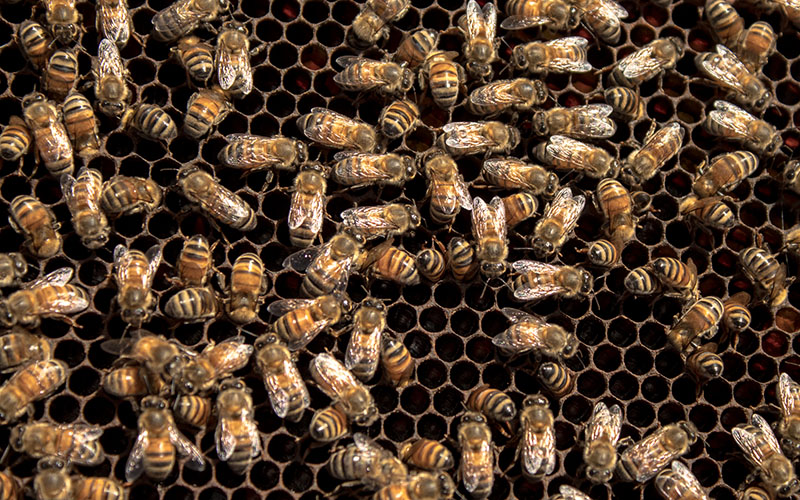
Honeybees from across the country are shipped to California every winter to pollinate the almond crop, a $300 million business. (Photo by Melina Zuniga/Cronkite News)
PHOENIX – Every winter, about 1.5 million honeybee colonies from all over the U.S. are shipped to California to pollinate almond trees. That’s almost 60 percent of the country’s 2.6 million colonies.
The $300 million managed pollination typically benefits almonds and bees alike. But in 2014, 80,000 of these bee colonies died or were deformed.
After combing through records maintained by the California Department of Pesticide Regulation, researchers at the Ohio State University and the College of Wooster in Ohio suspected certain insecticides and fungicides, previously considered harmless to bees, were to blame.
To test their hypothesis, they exposed honeybees to three insecticides (chlorantraniliprole, diflubenzuron and methoxyfenozide) and three fungicides (propiconazole, iprodione and a mixture of boscalid-pyraclostrobin).
The lab work showed that diflubenzuron, an insecticide used to counter the peach twig borer, a destructive moth caterpillar that feeds on almond as well as peach trees, could explain larval deaths.
Other deaths and developmental problems appeared to stem from a combination of chlorantraniliprole and propiconazole, an insecticide and a fungicide that are considered safe for honeybees when used independently.
“When you combine them together, there appears to be a synergistic interaction going on there that makes that combination toxic to both the developing larval bees as well as adult bees,” said co-author Reed Johnson, an Ohio State entomologist.
State records show that growers likely applied both chlorantraniliprole and propiconazole on certain days.
Given labor, cost and timing factors, this suggests applicators mixed the chemicals in the same tank and applied them together.
“They were using them because they thought it was fine. They didn’t think they were hurting the bees, but they were,” Johnson said.
A similar assumption might explain why scientists had not previously considered pesticides as possible culprits.
That, Johnson said, or researchers simply assumed that no insecticides were sprayed during the almond blossom pollination period.
“I mean, why on earth would you spray insecticide? Even if there’s no evidence that it’s going to cause harm, why would you spray insecticide at such a vulnerable time for honeybees – and such an important time for the almond growers?”
Johnson added that growers might have wanted to get a jump on the peach twig borer.
Diflubenzuron had been recommended for application during bloom, although some deleterious or harmful effects had been observed. The insecticide now carries a caution warning related to its effects on bees.
Johnson said the Environmental Protection Agency has expanded the list of tests required for pesticides undergoing registration or re-registration.
He added that the new tests would have caught the bee larva-killing insecticide.
“It still, however, would not have caught the synergistic effect from the tank-mix combination,” he said. “That’s still not a part of the standard protocol for getting a new pesticide registered and then formulating the advice to applicators that goes on the pesticide label.”
The Ohio team is investigating the effects of other insecticide and fungicide combinations.
This story is part of Elemental: Covering Sustainability, a multimedia collaboration between Cronkite News, Arizona PBS, KJZZ, KPCC, Rocky Mountain PBS and PBS SoCal.
Follow us on Twitter.

